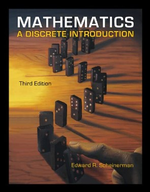Let X be a binomial random variable as in Example 33.5. Prove that E.X / D np
Chapter 34, Problem 34.11(choose chapter or problem)
Let X be a binomial random variable as in Example 33.5. Prove that E.X / D np.
Unfortunately, we don't have that question answered yet. But you can get it answered in just 5 hours by Logging in or Becoming a subscriber.
Becoming a subscriber
Or look for another answer
